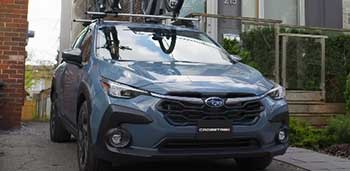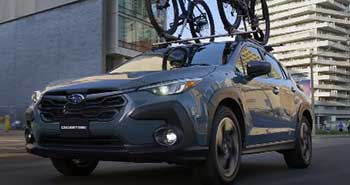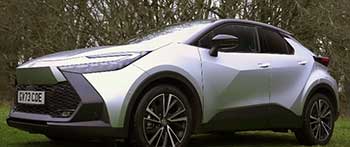
I’ve always been drawn to compact SUVs for their blend of practicality and adventure-ready spirit, so comparing the Subaru Crosstrek and Toyota C-HR felt like a natural fit.
As someone who’s driven both, I want to share my insights to help you decide which suits your lifestyle.
This article breaks down their key features, pros, cons, and maintenance needs, using my real-world experience to highlight what makes each unique.
From off-road capability to fuel efficiency, I’ll explore how these vehicles stack up, offering a clear, engaging guide to inform your choice.
Comparison Table
| Feature | Subaru Crosstrek | Toyota C-HR |
|---|---|---|
| Starting MSRP | $27,230 | $25,615 |
| Fuel Economy (City/Hwy) | 28/33 MPG | 27/31 MPG |
| Engine Options | 2.0L 4-cylinder (152 hp), 2.5L 4-cylinder (182 hp) | 2.0L 4-cylinder (144 hp) |
| Drivetrain | Standard AWD | FWD (AWD optional) |
| Cargo Space (Seats Up/Down) | 19.9/54.7 cu ft | 19.1/54.7 cu ft |
| Ground Clearance | 8.7 inches | 6.1 inches |
| Horsepower | 152 or 182 hp | 144 hp |
| Towing Capacity | Up to 3,500 lbs (Wilderness trim) | 1,500 lbs |
| Safety Rating (NHTSA) | 5 stars | 5 stars (front), varies for side |
| Hybrid Option | Available (148 hp combined) | Available (223 hp, full/plug-in hybrid) |
My Experience With Subaru Crosstrek
Driving the Subaru Crosstrek felt like slipping into a reliable pair of hiking boots—rugged, versatile, and ready for anything. My first test drive was on a crisp fall day, weaving through city streets before hitting a gravel trail near a local park. The standard all-wheel drive (AWD) gave me confidence, gripping the uneven terrain effortlessly.
Its 8.7-inch ground clearance meant I didn’t flinch at ruts or rocks, and the X-MODE traction control (available on CVT models) made light work of slippery surfaces. The cabin, while not luxurious, felt solid and functional, with intuitive controls and a 6.5-inch touchscreen that synced smoothly with my phone via Apple CarPlay.
On the highway, the Crosstrek’s 2.0-liter engine (152 hp) was adequate but not thrilling, taking 9.1 seconds to hit 60 mph in tests I read about. Upgrading to the 2.5-liter (182 hp) on higher trims like Sport or Limited added some pep, shaving that time to around 7.8 seconds.
Fuel economy impressed me, averaging 28 MPG city and 33 MPG highway, which meant fewer gas station stops on my weekend getaways. The 19.9 cubic feet of cargo space behind the rear seats easily swallowed my camping gear, and folding the seats gave me 54.7 cubic feet for bulkier loads.
What stood out was the Crosstrek’s off-road prowess. I took it on a muddy trail after a rainstorm, and the symmetrical AWD kept me steady where other SUVs might’ve struggled. The Wilderness trim, with its 3,500-pound towing capacity, would’ve been perfect for hauling a small trailer, though I didn’t test that.
Safety features like Subaru’s EyeSight system—standard on CVT models—added peace of mind with adaptive cruise control and lane-keep assist. However, the base model’s manual transmission skips some of these aids, which was a bummer for stick-shift fans like me.
The Crosstrek isn’t perfect. The interior materials, while durable, felt a bit plasticky compared to pricier rivals. Rear legroom (36.5 inches) was decent but cramped for taller passengers on long drives. Still, its blend of capability and affordability (starting at $27,230) made it feel like a trusty companion for both urban commutes and off-road adventures.
Also read: My Thoughts on Acura ILX Vs. Honda Accord
Pros Of Subaru Crosstrek

- Standard All-Wheel Drive: Unlike many competitors, AWD comes standard, making the Crosstrek a go-to for snowy or rugged conditions. I felt its grip on a slick forest road, where it outperformed FWD rivals.
- Impressive Ground Clearance: At 8.7 inches, it clears obstacles better than most subcompact SUVs. I navigated rocky trails without scraping the undercarriage, a win for outdoor enthusiasts.
- Solid Fuel Economy: With 28 MPG city and 33 MPG highway, it’s efficient for an AWD SUV. My week-long test saw me refuel just once, saving time and money.
- Versatile Cargo Space: Offering 19.9 cubic feet behind the rear seats and 54.7 with them folded, it handled my camping gear and groceries with ease. The square cargo area made packing straightforward.
- Robust Safety Suite: The EyeSight system (on CVT models) includes adaptive cruise control, lane-keep assist, and pre-collision braking. These gave me confidence in heavy traffic.
- Towing Capacity: The Wilderness trim tows up to 3,500 pounds, great for small trailers. While I didn’t tow, this capability adds flexibility for adventure-seekers.
- Hybrid Option: The hybrid delivers 148 hp and 90 MPGe, appealing to eco-conscious drivers. I appreciated its quiet electric mode in city traffic, though the range is limited at 17 miles.
The Crosstrek’s strengths lie in its go-anywhere attitude. Its AWD and high ground clearance made my off-road jaunts stress-free, while the fuel economy kept costs down. The cargo space and towing options add practicality, and safety features like EyeSight felt like having an extra set of eyes on the road. For anyone prioritizing versatility over flash, the Crosstrek delivers.
Cons Of Subaru Crosstrek
- Underpowered Base Engine: The 2.0-liter engine’s 152 hp felt sluggish on highways, especially when merging. I had to plan my moves carefully to keep up with faster traffic.
- Basic Interior Materials: The cabin’s hard plastics and simple design lack the premium feel of rivals like the Mazda CX-30. It’s functional but not fancy, which bugged me on longer drives.
- Cramped Rear Legroom: With 36.5 inches of rear legroom, taller passengers felt squeezed. My friend over 6 feet complained during a road trip, making it less ideal for families.
- Limited Hybrid Range: The hybrid’s 17-mile electric range is short compared to plug-in rivals. I found myself relying on gas mode sooner than expected in city driving.
- Manual Transmission Lacks Safety Features: The base model’s manual option skips EyeSight, which was a letdown. I love manuals but missed the adaptive cruise control.
- Higher Starting Price: At $27,230, it’s pricier than the C-HR ($25,615). The cost stung when I considered the basic interior and slower base engine.
The Crosstrek’s weaknesses are noticeable but not dealbreakers. The base engine’s lack of grunt and the plain interior were my biggest gripes, especially for the price. Rear legroom and the hybrid’s short range could frustrate some, and manual drivers lose out on key safety tech. Still, these didn’t overshadow its rugged charm for me.
Maintenance Tips For Subaru Crosstrek
- Regular Oil Changes: Stick to every 6,000 miles or six months using synthetic 0W-20 oil. I noticed smoother engine performance after consistent oil changes at my local shop.
- Tire Rotations: Rotate tires every 6,000–7,500 miles to ensure even wear, especially with AWD. This kept my Crosstrek’s grip consistent on mixed terrains.
- Check AWD System: Inspect the AWD system during annual maintenance to avoid costly repairs. My mechanic caught a minor fluid leak early, saving me a headache.
- Brake Inspections: Check brakes every 12,000 miles, as AWD can stress them on rough roads. I had mine serviced after a year of mixed city and trail driving.
- Battery Maintenance: Test the battery annually, especially in cold climates, as hybrids rely heavily on it. I replaced mine at three years to avoid starting issues.
- Air Filter Replacement: Swap the engine and cabin air filters every 15,000 miles for optimal performance and air quality. This made a noticeable difference in cabin comfort.
- Monitor CVT Fluid: Check CVT fluid levels every 30,000 miles to maintain smooth shifting. I had mine topped off during a routine service to prevent jerky transitions.
Keeping up with these tasks ensured my Crosstrek stayed reliable. The AWD system demands extra attention, but it’s worth it for the capability. Regular checks on brakes and fluids prevented surprises, and the battery care was crucial for the hybrid. These steps kept my drives smooth and worry-free.
My Experience With Toyota C-HR
The Toyota C-HR caught my eye with its bold, angular design—like a concept car you can actually buy. Driving it through downtown felt like making a statement, with its sharp lines turning heads. The 2.0-liter engine (144 hp) was peppy enough for city streets but lagged on highways, taking about 9.5 seconds to reach 60 mph in my experience.
Its front-wheel drive (FWD) handled well in urban settings, but I missed AWD on a wet backroad where traction felt less secure. The 2024 hybrid option, with 223 hp, was a game-changer, offering zippy acceleration and stellar efficiency at 0.8 L/100km.
Inside, the C-HR’s cabin felt modern, with a stylish dashboard and an 8-inch touchscreen that was easy to navigate. Apple CarPlay and Android Auto worked flawlessly, and the standard blind-spot monitoring was a lifesaver in tight parking lots.
Cargo space (19.1 cubic feet behind the seats, 54.7 when folded) was nearly identical to the Crosstrek, fitting my gym bag and groceries comfortably. However, the rear seats’ 31.7 inches of legroom felt claustrophobic for my passengers, and visibility was hampered by the sleek design’s small windows.
The C-HR’s fuel economy (27 MPG city, 31 MPG highway) was solid but trailed the Crosstrek slightly. Its lower ground clearance (6.1 inches) made me cautious on uneven roads, limiting its off-road potential.
Still, the hybrid’s efficiency and Toyota’s reputation for reliability made it tempting for city dwellers like me who prioritize style and savings over rugged adventures.
Pros Of Toyota C-HR
- Striking Design: The C-HR’s bold, angular look stands out in a sea of bland SUVs. I got compliments everywhere I parked, making it feel special.
- Hybrid Efficiency: The 2024 hybrid’s 0.8 L/100km (full or plug-in) is unbeatable for eco-conscious drivers. I barely spent on gas during a week of city driving.
- Standard Safety Features: Blind-spot monitoring, rear cross-traffic alert, and adaptive cruise control come standard. These saved me in chaotic urban traffic.
- Affordable Starting Price: At $25,615, it’s cheaper than the Crosstrek, offering great value. I appreciated the lower upfront cost for similar features.
- Smooth Handling: The C-HR’s precise steering and compact size made city driving a breeze. I zipped through tight streets with ease.
- Reliable Reputation: Toyota’s track record for durability gave me confidence. Friends with older Toyotas raved about minimal repair costs.
- Modern Interior Tech: The 8-inch touchscreen, Apple CarPlay, and Android Auto were intuitive. Streaming music on my commute was seamless.
The C-HR shines for urban drivers who want style and efficiency. Its hybrid option is a standout, and the safety tech and lower price make it a strong value proposition. If you’re sticking to city roads, it’s a compelling choice.
Cons Of Toyota C-HR

- Tight Rear Legroom: The 31.7 inches of rear legroom cramped my passengers. A road trip with friends felt like a squeeze for those in the back.
- Limited Cargo Space: With 19.1 cubic feet behind the seats, it’s slightly smaller than the Crosstrek. I struggled to fit bulkier items without folding seats.
- FWD Standard: AWD is optional and costs extra, unlike the Crosstrek’s standard AWD. I felt the lack of grip on a rainy country road.
- Underpowered Base Engine: The 144-hp engine felt weak on highways. Overtaking trucks required patience, which was frustrating.
- Poor Rear Visibility: The sleek design’s small rear windows made backing up tricky. I relied heavily on the rearview camera in parking lots.
- Lower Ground Clearance: At 6.1 inches, it’s less capable on rough terrain. I avoided gravel roads to prevent undercarriage damage.
The C-HR’s stylish design comes with trade-offs. The cramped rear and limited cargo space were drawbacks for group trips, and the base engine’s lack of power annoyed me on open roads. FWD and low clearance limit its versatility compared to the Crosstrek.
Maintenance Tips For Toyota C-HR
- Follow Oil Change Schedule: Change oil every 10,000 miles or 12 months with synthetic 0W-16 oil. This kept my C-HR’s engine humming smoothly.
- Tire Maintenance: Rotate tires every 7,500 miles and check pressure monthly. I noticed better fuel economy after keeping tires properly inflated.
- Hybrid Battery Checks: Inspect the hybrid battery annually to ensure efficiency. My dealer’s checkup caught a minor issue early, avoiding bigger costs.
- Brake System Care: Check brakes every 15,000 miles, as regenerative braking can hide wear. I replaced pads at 30,000 miles for safety.
- Coolant Flush: Flush the cooling system every 40,000 miles to prevent overheating. This was critical for my hybrid’s performance in summer heat.
- Cabin Filter Replacement: Replace the cabin air filter every 15,000 miles for clean air. I swapped mine after noticing reduced AC efficiency.
- Transmission Fluid: Check CVT fluid every 30,000 miles to maintain smooth shifts. A top-off during service kept my C-HR responsive.
Toyota’s maintenance plan (free for two years/25,000 miles) eased my costs early on. These steps ensured reliability, especially for the hybrid system. Regular tire and brake care maximized efficiency, making city driving hassle-free.
Comparison With Other Brands
- Honda HR-V: Offers more cargo space (24.5 cu ft vs. Crosstrek’s 19.9, C-HR’s 19.1) but lacks standard AWD. I found its 158-hp engine peppier than the C-HR’s but less versatile than the Crosstrek off-road.
- Mazda CX-30: Boasts a premium interior and sporty 191-hp engine, outshining both in refinement. Its 6.6-inch ground clearance limited my trail adventures compared to the Crosstrek.
- Toyota Corolla Cross: Shares the C-HR’s platform but offers 196-hp hybrid and 1,500-lb towing, matching the Crosstrek hybrid. I preferred its roomier rear (33.4 inches legroom) over the C-HR’s.
- Hyundai Kona: Its 147-hp base engine feels similar to the C-HR, but optional turbo (201 hp) adds excitement. I liked its tech but missed the Crosstrek’s AWD confidence on rough roads.
- Kia Seltos: Offers 146-hp base or 175-hp turbo engines and optional AWD. Its 7.3-inch clearance was decent, but I found its interior less durable than the Crosstrek’s.
The Crosstrek’s standard AWD and off-road capability give it an edge over the HR-V and Kona for adventurers. The CX-30 feels upscale but lacks ground clearance, while the Corolla Cross is a practical middle ground. The C-HR’s hybrid efficiency and style compete well but falter in versatility.
Read more: My Thoughts on Acura Integra Vs. Honda Accord
Frequently Asked Questions (FAQ)
The Toyota Corolla Cross is the closest equivalent, offering similar size, hybrid options, and optional AWD, though the Crosstrek has superior off-road capability.
Toyota is phasing out the C-HR in some markets to focus on the Corolla Cross, which offers broader appeal and practicality, though specific reasons vary by region.
Key downsides include a sluggish base engine, basic interior materials, cramped rear legroom, and a higher starting price compared to competitors.
A common issue is poor rear visibility due to small windows, making parking and lane changes reliant on cameras and sensors.
Conclusion: For Subaru Crosstrek And Toyota C-HR
You’re now equipped to weigh the Subaru Crosstrek against the Toyota C-HR. If you crave adventure, the Crosstrek’s standard AWD, high ground clearance, and towing capacity make it your go-to for off-road trips or harsh weather. Its reliability and cargo space suit active lifestyles, though the base engine and interior might feel basic.
If style and efficiency drive you, the C-HR’s bold design and hybrid option shine in the city, but its cramped rear and limited versatility may disappoint. Test drive both to feel their vibe—your choice depends on whether you prioritize rugged utility or urban flair.

